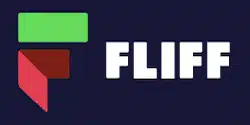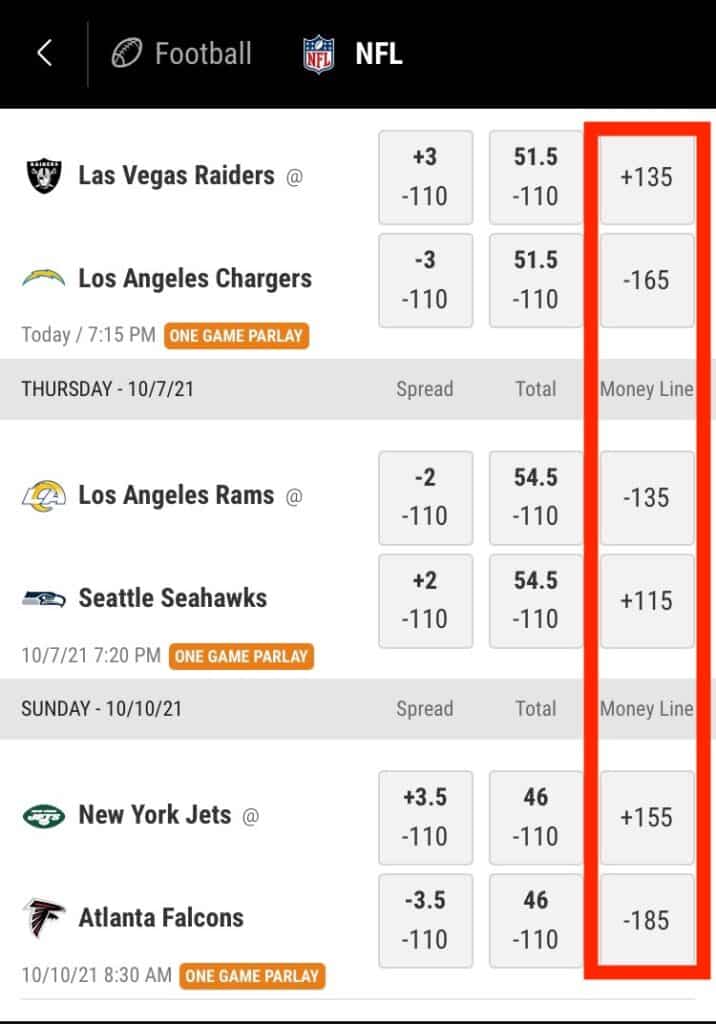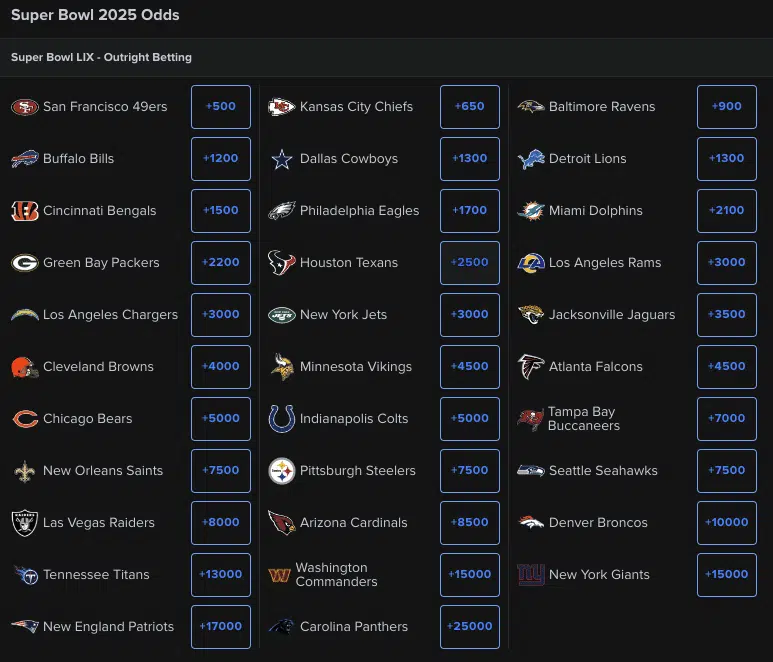Bettors will be hard-pressed to find a more straightforward wagering format than the moneyline.
All bettors have to do is pick a team or athlete to win and collect their payout if that side emerges victorious. It’s as simple as it sounds. A moneyline bet is no more complicated than predicting the outright winner of a game or contest.
Of course, there is more nuance to the moneyline betting format. Bettors aiming for success must learn how to read moneyline odds, understand why the odds are constantly in flux, and distinguish good lines from bad.
Winning may be the name of the game, but demystifying that confusion is the first step toward success. Let’s get started.
Moneyline Betting Sites
 Play $5, Get $50 in LineupsPrizePicks Promo Code: BUSA
$50 provided as promo funds, only for use on PrizePicks. Promo funds provided under this promotion must be played within 90 days of receipt or shall become null and void at PrizePicks’ discretion. Promo ends 12/31/25. Void where prohibited. If you or someone you know has a gaming problem, get help. Crisis services and responsible gaming counseling can be accessed by calling 1-800-426-2537 or online at www.ncpgambling.org. 18+ in most eligible jurisdictions, but other age and eligibility restrictions may apply. Valid only in jurisdictions where PrizePicks operates. See prizepicks.com/terms for full PrizePicks terms of service.
Play $5, Get $50 in LineupsPrizePicks Promo Code: BUSA
$50 provided as promo funds, only for use on PrizePicks. Promo funds provided under this promotion must be played within 90 days of receipt or shall become null and void at PrizePicks’ discretion. Promo ends 12/31/25. Void where prohibited. If you or someone you know has a gaming problem, get help. Crisis services and responsible gaming counseling can be accessed by calling 1-800-426-2537 or online at www.ncpgambling.org. 18+ in most eligible jurisdictions, but other age and eligibility restrictions may apply. Valid only in jurisdictions where PrizePicks operates. See prizepicks.com/terms for full PrizePicks terms of service.
*The options available in your state are fantasy pick’em apps and social sportsbooks, not technically sports betting.
Moneyline Bets Explained
Most online sportsbooks publish their moneyline bets on their home page and the front page of every sports category. Suffice to say, moneylines aren’t difficult to locate.
Sportsbooks may feature their moneyline markets independently on occasion, but they typically post them alongside each game’s point spread and total (over/under). Below is an example of where bettors will find the moneyline markets on a typical sports betting app:
Sports compatible with moneyline bets include football, basketball, baseball, hockey, boxing, MMA, tennis, soccer, and many more. If a sport exists, then there’s a good chance bettors can place moneyline wagers on it.
Understanding Moneyline Odds
US sportsbooks use American odds by default, so bettors need to understand how they work as a beginning point.
In the image above, each moneyline market features a team with “+” odds and a team with “-“ odds. In the American odds format, the plus sign denotes the underdog and the minus sign the favorite.
Bigger numbers represent a larger disparity between the two teams, and smaller numbers indicate more parity in the matchup. For example, if the split is -135/+115 as it is for the Rams and Seahawks game in the above screenshot, it indicates the two teams are somewhat evenly matched.
However, if the line was instead +320/-400, it would suggest the favorite is a much better team than the dog.
Moneyline odds function on the concept of betting 100 units:
- For favorites (“-“ odds): Risk the absolute value of the moneyline amount to win $100.
- For underdogs (“+” odds): Risk $100 to win the moneyline amount.
For example, imagine tonight’s Knicks and Hawks game has the Hawks as -200 favorites and the Knicks at +160. Thus, a $200 bet on the Hawks at -200 would yield a $100 profit.
On the other hand, a $100 bet on the underdog Knicks would yield $160 in profit if they pull off the upset.
Of course, the moneyline format does not lock bettors into betting those exact amounts. A better could just as easily bet $20 on the Hawks for a shot at $10 in profit based on the following formula:
bet size/(-odds/100) = moneyline favorite profits
For underdogs:
bet size * (odds/100) = moneyline underdog profits
Using this calculation, a $30 bet on the +160 Knicks wins: $30 * (160/100) = $48. Remember, the $48 is just the profit amount. The bettor would also receive back their $30 initial stake for a total payout of $78.
Two-way vs. Three-way Moneylines and Futures
Most moneylines are two-way moneylines, in that bettors can only place a “to win” bet on one of two teams or players. Two teams, two outcomes, two-way – makes sense.
There are three possible outcomes in two-way moneyline wagers:
- Selected team wins: bettor receives their original stake plus profits
- Selected team loses: bettor loses their stake
- Draw or “no bet”: Sportsbook returns the initial stake in full
Sportsbooks offer two-way moneylines on contests in which a draw is unlikely or impossible. For example, there are no ties in baseball and basketball, and they’re rare in the NFL. As a result, most moneyline wagers involving those sports are of the two-way variety.
In sports such as soccer and MMA, where ties are commonplace, sportsbooks are more likely to offer three-way moneylines. A three-way moneyline works just like its two-way counterpart but adds the draw outcome as an option. Additionally, the addition of the tie outcome means bettors who bet on one team or the other lose their wagers if the game ends in a draw.
Three-way moneylines on FanDuel Sportsbook look like this:
Another point of interest: Notice that for the Newcastle/Leads game, both teams feature “+” odds to win outright. But how could that be? The reason is that when a draw is a likely outcome, the chances of an outright winner become slimmer. Sometimes they become long enough that the favorite, in this case Leads, moves across +100.
Futures are another form of moneyline wager. With futures, you’re often betting on one of many teams to win something outright, be it a division, a conference, or the Super Bowl. Futures aren’t subject to draws, so bettors will either win their wager or lose it.
Here’s a look at Super Bowl futures on FanDuel:
Notice that not a single team has “-“ odds. That’s because in a league with 32 teams, it’s exceedingly rare for one team to boast even odds or better to win it all – although it can happen.
In-Play Moneyline Betting
Most sportsbooks offer in-play moneyline wagers that bettors can place during games.
The main difference between regular and in-play moneylines is that the latter will always be in flux. With every snap of the football or rebound of the basketball, the line will move. Pregame favorites can quickly become underdogs if they find themselves in an early hole, and underdogs can become even longer shots if they’re getting blown out.
Sports betting tech has increased to the point where up-to-the-moment line movement is possible. However, in-play moneylines are still not nearly as accurate as their pregame counterparts, so the juice is typically higher.
How to Place a Moneyline Wager
Sportsbooks post pregame moneylines on the front page of each sports category. So, for any given book, here’s how bettors can place a moneyline wager:
- Log in to your online sports betting account.
- Navigate to the sport or league of your choice.
- Most betting apps also provide a listing of popular pregame and in-play moneyline bets on the homepage.
- Find an attractive wager under “Moneyline” and click or tap it.
- The bet slip will appear somewhere on the screen. The placement varies from book to book, but it’s always easily visible.
- Enter the amount you want to wager and hope the line doesn’t move in an unfavorable direction before your book processes your wager. If the line does move against you, your book should display a pop-up notice allowing you to accept or reject the new line.
- (Optional) Add more wagers to turn your straight bet into a parlay.
Note: Sportsbooks calculate bettors’ potential winnings and display it on the betting slip so they can see exactly how much they stand to win or lose before they confirm their wagers.
For context, here’s a look at the DraftKings Sportsbook betting slip:
In this case, a longshot $50 moneyline bet on Nebraska at +900 would pay $50 (initial stake) plus $450 in profits should the Cornhuskers pull off a minor miracle.
Moneylines vs. Point Spreads
What’s the difference between moneyline betting and point spread?
Whereas moneylines are straight bets on outright winners, point spreads employ handicaps to make the odds on each team winning relatively even.
Point spreads try to create parity by giving a certain number of points to the underdog and taking that same amount from the favorite. The result is the payout odds on each side are equivalent, often priced at -105/-105 or -110/-110. It is also common for there to be a slight disparity, such as -105/-115 or -109/-112.
For example, if a sportsbook deems the Bears moderate favorites over the Saints, it might give something like 3.5 points to the Saints. As a result, any wager on the Bears only cashes if they win by four or more points. Likewise, any bets on the underdog Saints cash if the Saints win outright or lose by fewer than four points.
The moneyline odds on this theoretical matchup might be something like -195/+165, which also reflects the Bears as moderate but not overwhelming favorites.
As a result, there is a high correlation between the point spread and the moneyline because the moneyline reflects how many points are needed to even the odds. Big point spreads like 12.5 or 13 translate to longshot moneyline odds on the dog and a tiny payout on the favorite – something like -600/+450.
One final note is that the correlation from moneyline to point spread differs per sport. In baseball, a 3-run underdog represents a team that is barely in the same league as its opponent, and that will reflect in the dog receiving extremely long moneyline odds.
But in high-scoring sports like football and basketball, a 3-point underdog is a worthy adversary, and the moneyline will hover much closer to 100.
Implied Probability and Calculating Juice
One of the most important tools in a bettor’s arsenal is learning how to convert moneyline odds to their implied probabilities.
American odds have a reputation for being notoriously difficult to read. Luckily, converting them to percentage odds is straightforward:
- Negative odds (favorites): (-odds)/(-odds + 100)
- Positive odds (underdog): 100/(odds + 100)
Let’s put these equations to work using a practical example. Say the Giants are a +300 moneyline dog against the Eagles at -400.
The implied probability of the Giants scoring an upset are 100/(300 + 100) = 25%. Likewise, the implied probability for the Eagles to win is (-(-400)/(-(-400) + 100) = 400/(400 + 100) = 80%.
Hold on a second? Shouldn’t the probabilities add up to 100%? If you made this astute observation, then pat yourself on the back.
Yes, it’s true that in this instance, the implied probabilities total 25% + 80% = 105%. The reasoning for this apparent rounding error is the VIG, or juice, that the house charges for the privilege of placing wagers at its book.
In other words, sportsbooks take a small cut of every winning wager. In our Giants/Eagles example, the VIG is 4.76%, slightly more than average for a moneyline wager. By contrast, the VIG on a standard -110/-110 point spread is 4.54%.
The gap between two moneylines is where the VIG originates. In an ideal world, the Giants/Eagles game would have a moneyline of around +320/-320. This “No-VIG” line would produce break-even results over the long run and cause the sportsbook to go belly up.
Now, it’s important to note that a large gap doesn’t necessarily equate to an enormous VIG. Beginners often make the mistake of thinking that a -200/+150 split is worlds better than a -800/+600 line because the gap is smaller.
Nope. The VIG on the former is a hefty 6.25%, while the juice on the -800/+600 line is just 3.07%. The reason for this is that implied probabilities change at a slower rate the further you move away from 100. When in doubt, do the math or use an implied probability calculator.
Reducing the Juice on Moneyline Bets
There are a few ways that even total beginners can reduce the juice on a moneyline wager. The first, and perhaps the easiest, is to line shop. If Book A offers a moneyline at -195/+155 and Book B has it at -190/+160, then Book B is the obvious choice no matter which team the bettor intends to back.
Going a bit deeper, bettors can reduce the juice by combining moneylines. To clarify, imagine Book A features a moneyline of -240/+200, and Book B has the same bet at -220/+180. Taking the underdog from Book A and the favorite from Book B creates an effective moneyline of +200/-220, reducing the vig to just 2.04%.
Using this method alone, it is often possible to reduce the juice to less than 1% because different sportsbooks tend to take slightly different positions.
Bettors can also take advantage of betting promotions such as profit boosts. Imagine a sportsbook has a moneyline wager priced at -240/+200. The vig on this bet is already a reasonable 3.75%, making it an attractive target for a profit boost.
If the profit boost promo is 20% and the bettor takes the underdog for $25, they stand to win $60 instead of $50. Earning a $60 payout in this example would have required a line of +240, which means the bettor eliminated the juice by using the profit boost on that market – creating a moneyline effectively priced at -240/+240.
Generating Positive EV
One intermediate technique is to jump on stale lines immediately after a game-changing event, like when a starting lineup is announced in baseball, or a player’s gametime status is revealed in basketball.
Sometimes recreational books are slow to react to these events, and fans can land a bargain. The stale line may be significantly better than the closing line, generating a healthy amount of closing line value (CLV).
This technique requires a bit more effort, and bettors need to study the markets. It’s best for newbies to start with one market and expand. Bettors should also know that if they consistently generate CLV, the sportsbook may limit them.
Moneyline Bets FAQ
Robert Dellafave is an expert sports bettor, professional gambler, and advocate for the fair treatment of sports bettors.





